Assessment of Electrical Resistivity and Oxygen Diffusion Coefficient of Cementitious Materials from Microstructure Features
Abstract
1. Introduction
2. Experimental Program
2.1. Materials and Mixture Design
2.2. Sample Preparation
2.3. Modified Non-Contact Electrical Resistivity Measurement
2.3.1. Test Principal
2.3.2. Test Procedure
2.4. Oxygen Diffusion Measurement
2.5. MIP Test
3. Results and Discussion
3.1. Electrical Resistivity and MIP Measurement Results
3.2. Oxygen Diffusion Coefficient Determination
3.3. Quantitative Correlation between Porosity, Oxygen Diffusion Coefficient and Electrical Resistivity
3.4. Practical Application
4. Conclusions
- The modified non-contact electrical resistivity measurement can determine the electrical resistivity of cementitious materials, the measurement results is highly stable and repeatable.
- The universal equation can be used to estimate the capillary porosity from the measured electrical resistivity results.
- The oxygen diffusion coefficient of cementitious materials can be assessed from the measured electrical resistivity results and capillary porosity results by the following equation: .
- The error of oxygen diffusion coefficient determination results by the proposed assessment equation have 95% confidence to drawn within normality distributed population in 5% decision level, the assessment equation can be practically applied to assess the oxygen diffusion coefficient of cementitious materials.
Author Contributions
Funding
Institutional Review Board Statement
Informed Consent Statement
Data Availability Statement
Conflicts of Interest
References
- He, R.; Ye, H.; Ma, H.; Fu, C.; Jin, X.; Li, Z. Correlating the Chloride Diffusion Coefficient and Pore Structure of Cement-Based Materials Using Modified Noncontact Electrical Resistivity Measurement. J. Mater. Civ. Eng. 2019, 31, 04019006. [Google Scholar] [CrossRef]
- He, R.; Fu, C.; Ma, H.; Ye, H.; Jin, X. Prediction of Effective Chloride Diffusivity of Cement Paste and Mortar from Microstructural Features. J. Mater. Civ. Eng. 2020, 32, 04020211. [Google Scholar] [CrossRef]
- Chen, J.; Wang, J.; He, R.; Shu, H.; Fu, C. Experimental Study on Effective Chloride Diffusion Coefficient of Cement Mortar by Different Electrical Accelerated Measurements. Crystals 2021, 11, 240. [Google Scholar] [CrossRef]
- Huang, Y.; Ye, H.; Fu, C.; Jin, N. Modeling moisture transport at the surface layer of fatigue-damaged concrete. Constr. Build. Mater. 2017, 151, 196–207. [Google Scholar] [CrossRef]
- Zhou, C.; Chen, W.; Wang, W.; Skoczylas, F. Unified determination of relative molecular diffusivity and fluid permeability for partially saturated cement-based materials. Cem. Concr. Res. 2015, 67, 300–309. [Google Scholar] [CrossRef]
- Sercombe, J.; Vidal, R.; Gallé, C.; Adenot, F. Experimental study of gas diffusion in cement paste. Cem. Concr. Res. 2007, 37, 579–588. [Google Scholar] [CrossRef]
- Gui, Q.; Qin, M.; Li, K. Gas permeability and electrical conductivity of structural concretes: Impact of pore structure and pore saturation. Cem. Concr. Res. 2016, 89, 109–119. [Google Scholar] [CrossRef]
- Liu, X.; Zhang, W.; Gu, X.; Ye, Z. Probability distribution model of stress impact factor for corrosion pits of high-strength prestressing wires. Eng. Struct. 2021, 230, 111686. [Google Scholar] [CrossRef]
- Fu, C.; Fang, D.; Ye, H.; Huang, L.; Wang, J. Bond degradation of non-uniformly corroded steel rebars in concrete. Eng. Struct. 2021, 226, 111392. [Google Scholar] [CrossRef]
- Fu, C.; Huang, J.; Dong, Z.; Yan, W.; Gu, X.L. Experimental and numerical study of an electromagnetic sensor for non-destructive evaluation of steel corrosion in concrete. Sens. Actuators A Phys. 2020, 315, 112371. [Google Scholar] [CrossRef]
- Chen, H.; Huang, X.; He, R.; Zhou, Z.; Fu, C.; Wang, J. Mechanical Properties of Polypropylene Fiber Cement Mortar under Different Loading Speeds. Sustainability 2021, 13, 3697. [Google Scholar] [CrossRef]
- Chen, H.; Zhou, X.; Li, Q.; He, R.; Huang, X. Dynamic Compressive Strength Tests of Corroded SFRC Exposed to Drying–Wetting Cycles with a 37 mm Diameter SHPB. Materials 2021, 14, 2267. [Google Scholar] [CrossRef] [PubMed]
- Liu, X.; Zhang, W.; Gu, X.; Zeng, Y. Degradation of Mechanical Behavior of Corroded Prestressing Wires Subjected to High-Cycle Fatigue Loading. J. Bridge Eng. 2017, 22, 04017004. [Google Scholar] [CrossRef]
- He, R.; Ma, H.; Hafiz, R.B.; Fu, C.; Jin, X.; He, J. Determining porosity and pore network connectivity of cement-based materials by a modified non-contact electrical resistivity measurement: Experiment and theory. Mater. Des. 2018, 156, 82–92. [Google Scholar] [CrossRef]
- Polder, R.B. Test methods for on site measurement of resistivity of concrete-a RILEM TC-154 technical recommendation. Constr. Build. Mater. 2001, 15, 125–131. [Google Scholar] [CrossRef]
- Karhunen, K.; Seppanen, A.; Lehikoinen, A.; Monteiro, P.J.M.; Kaipio, J.P. Electrical Resistance Tomography imaging of concrete. Cem. Concr. Res. 2010, 40, 137–145. [Google Scholar] [CrossRef]
- ASTM C1202-12. Standard Test Method for Electrical Indication of Concrete’s Ability to Resist Chloride Ion Penetration; ASTM International: West Conshohocken, PA, USA, 2012. [Google Scholar]
- Gowers, K.R.; Millard, S.G. Measurement of concrete resistivity for assessment of corrosion severity of steel using wenner technique. ACI Mater. J. 1999, 96, 536–541. [Google Scholar] [CrossRef]
- Neithalath, N.; Weiss, J.; Olek, J. Characterizing Enhanced Porosity Concrete using electrical impedance to predict acoustic and hydraulic performance. Cem. Concr. Res. 2006, 36, 2074–2085. [Google Scholar] [CrossRef]
- Snyder, K.A.; Ferraris, C.; Martys, N.S.; Garboczi, E.J. Using Impedance Spectroscopy to Assess the Viability of the Rapid Chloride Test for Determining Concrete Conductivity. J. Res. Natl. Inst. Stand. Technol. 2000, 105, 497–509. [Google Scholar] [CrossRef]
- McCarter, W.J.; Starrs, G.; Chrisp, T.M. Electrical conductivity, diffusion, and permeability of Portland cement-based mortars. Cem. Concr. Res. 2000, 30, 1395–1400. [Google Scholar] [CrossRef]
- Li, Z.; Wei, X.; Li, W. Preliminary Interpretation of Portland Cement Hydration Process Using Resistivity Measurements. ACI Mater. J. 2003, 100, 253–257. [Google Scholar] [CrossRef]
- Xiao, L.; Li, Z. Early-age hydration of fresh concrete monitored by non-contact electrical resistivity measurement. Cem. Concr. Res. 2008, 38, 312–319. [Google Scholar] [CrossRef]
- Xiao, L.Z.; Li, Z.J.; Wei, X.S. Selection of superplasticizer in concrete mix design by measuring the early electrical resistivities of pastes. Cem. Concr. Compos. 2007, 29, 350–356. [Google Scholar] [CrossRef]
- Zhang, J.; Li, Z. Application of GEM Equation in Microstructure Characterization of Cement-Based Materials. J. Mater. Civ. Eng. 2009, 21, 648–656. [Google Scholar] [CrossRef]
- Zhang, W.; Zhang, Y. Apparatus for monitoring the resistivity of the hydration of cement cured at high temperature. Instrum. Sci. Technol. 2017, 45, 151–162. [Google Scholar] [CrossRef]
- Li, Z.; Li, W. Contactless, Transformer-Based Measurement of the Resistivity of Materials. U.S. Patent 6639401B2, 28 October 2003. [Google Scholar]
- Thiery, M.; Villain, G.; Dangla, P.; Platret, G. Investigation of the carbonation front shape on cementitious materials: Effects of the chemical kinetics. Cem. Concr. Res. 2007, 37, 1047–1058. [Google Scholar] [CrossRef]
- Jiang, Z.; Huang, Q.; Xi, Y.; Gu, X.; Zhang, W. Experimental Study of Diffusivity of the Interfacial Transition Zone between Cement Paste and Aggregate. J. Mater. Civ. Eng. 2016, 28, 04016109. [Google Scholar] [CrossRef]
- Linares-Alemparte, P.; Andrade, C.; Baza, D. Porosity and electrical resistivity-based empirical calculation of the oxygen diffusion coefficient in concrete. Constr. Build. Mater. 2019, 198, 710–717. [Google Scholar] [CrossRef]
- Hamami, A.A.; Turcry, P.; Aït-Mokhtar, A. Influence of mix proportions on microstructure and gas permeability of cement pastes and mortars. Cem. Concr. Res. 2012, 42, 490–498. [Google Scholar] [CrossRef]
- Fu, C.; Ling, Y.; Wang, K. An innovation study on chloride and oxygen diffusions in simulated interfacial transition zone of cementitious material. Cem. Concr. Compos. 2020, 110, 103585. [Google Scholar] [CrossRef]
- ASTM C150/C150M-20. Standard Specification for Portland Cement; ASTM International: West Conshohocken, PA, USA, 2020. [Google Scholar]
- MacDonald, K.A.; Northwood, D.O. Experimental measurements of chloride ion diffusion rates using a two-compartment diffusion cell: Effects of material and test variables. Cem. Concr. Res. 1995, 25, 1407–1416. [Google Scholar] [CrossRef]
- Xiao, L.; Ren, Z.; Shi, W.; Wei, X. Experimental study on chloride permeability in concrete by non-contact electrical resistivity measurement and RCM. Constr. Build. Mater. 2016, 123, 27–34. [Google Scholar] [CrossRef]
- Zeng, Q.; Li, K.; Fen-Chong, T.; Dangla, P. Pore structure characterization of cement pastes blended with high-volume fly-ash. Cem. Concr. Res. 2012, 42, 194–204. [Google Scholar] [CrossRef]
- Diamond, S. Mercury porosimetry: An inappropriate method for the measurement of pore size distributions in cement-based material. Cem. Concr. Res. 2000, 30, 1517–1525. [Google Scholar] [CrossRef]
- Washburn, E.W. Note on a Method of Determining the Distribution of Pore Sizes in a Porous Material. Proc. Natl. Acad. Sci. USA 1921, 7, 115–116. [Google Scholar] [CrossRef] [PubMed]
- Archie, G.E. The Electrical Resistivity Log as an Aid in Determining Some Reservoir Characteristics. Trans. AIME 1942, 146, 54–62. [Google Scholar] [CrossRef]
- Spragg, R.; Villani, C.; Weiss, J. Electrical Properties of Cementitious Systems: Formation Factor Determination and the Influence of Conditioning Procedures. Adv. Civ. Eng. Mater. 2016, 5, 124–148. [Google Scholar] [CrossRef]
- Bernabé, Y.; Zamora, M.; Li, M.; Maineult, A.; Tang, Y.B. Pore connectivity, permeability, and electrical formation factor: A new model and comparison to experimental data. J. Geophys. Res. Solid Earth 2011, 116. [Google Scholar] [CrossRef]
- Tumidajski, P.J. Relationship between resistivity, diffusivity and microstructural descriptors for mortars with silica fume. Cem. Concr. Res. 2005, 35, 1262–1268. [Google Scholar] [CrossRef]
- Christensen, B.J.; Coverdale, T.; Olson, R.A.; Ford, S.J.; Garboczi, E.J.; Jennings, H.M.; Mason, T.O. Impedance Spectroscopy of Hydrating Cement-Based Materials: Measurement, Interpretation, and Application. J. Am. Ceram. Soc. 1994, 77, 2789–2804. [Google Scholar] [CrossRef]
- Zhang, J. Microstructure Study of Cementitious Materials Using Resistivity Measurement. Ph.D. Thesis, Hong Kong University of Science and Technology, Hong Kong, China, 2008. [Google Scholar]
- Tumidajski, P.J. Electrical conductivity of Portland cement mortars. Cem. Concr. Res. 1996, 26, 529–534. [Google Scholar] [CrossRef]
- Tumidajski, P.J.; Schumacher, A.S.; Perron, S.; Gu, P.; Beaudoin, J.J. On the relationship between porosity and electrical resistivity in cementitious systems. Cem. Concr. Res. 1996, 26, 539–544. [Google Scholar] [CrossRef]
- Andrade, C. Calculation of chloride diffusion coefficients in concrete from ionic migration measurements. Cem. Concr. Res. 1993, 23, 724–742. [Google Scholar] [CrossRef]
- Sanchez, J.; Andrade, C.; Torres, J.; Rebolledo, N.; Fullea, J. Determination of reinforced concrete durability with on-site resistivity measurements. Mater. Struct. Constr. 2017. [Google Scholar] [CrossRef]
- Castellote, M.; Andrade, C.; Alonso, C. Measurement of the steady and non-steady-state chloride diffusion coefficients in a migration test by means of monitoring the conductivity in the anolyte chamber. Comparison with natural diffusion tests. Cem. Concr. Res. 2001. [Google Scholar] [CrossRef]
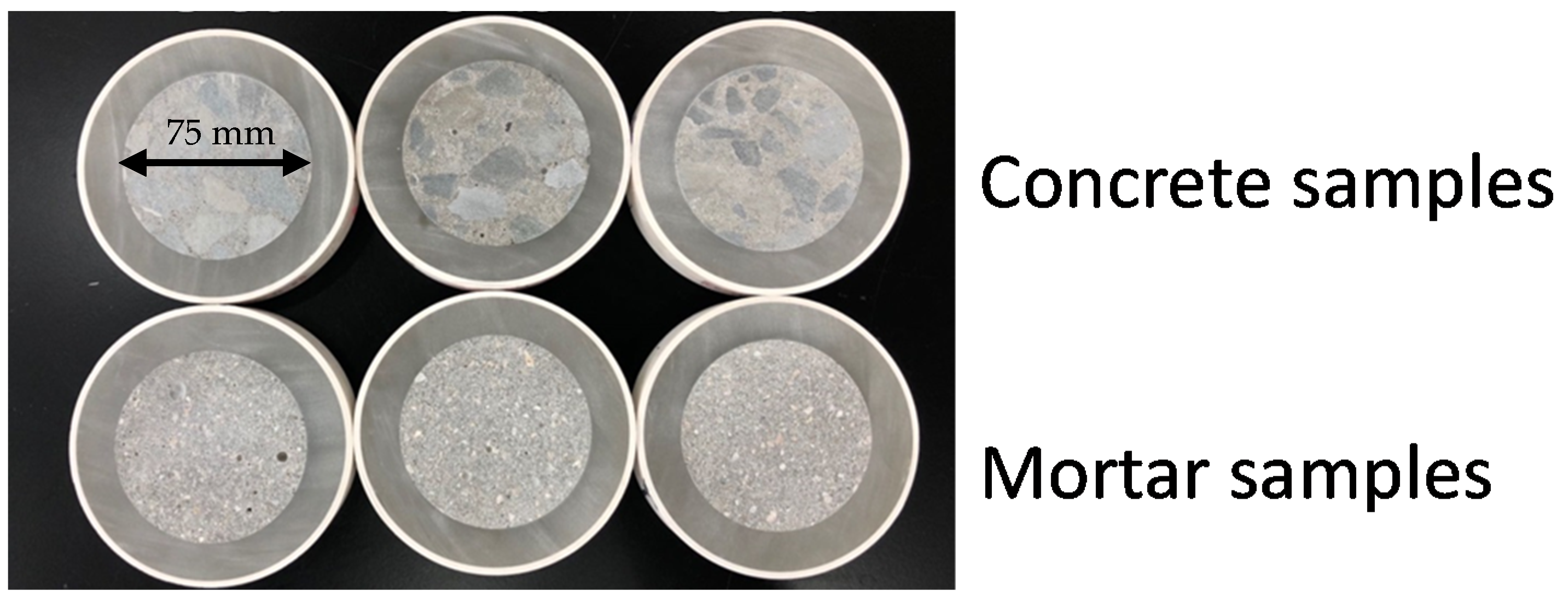
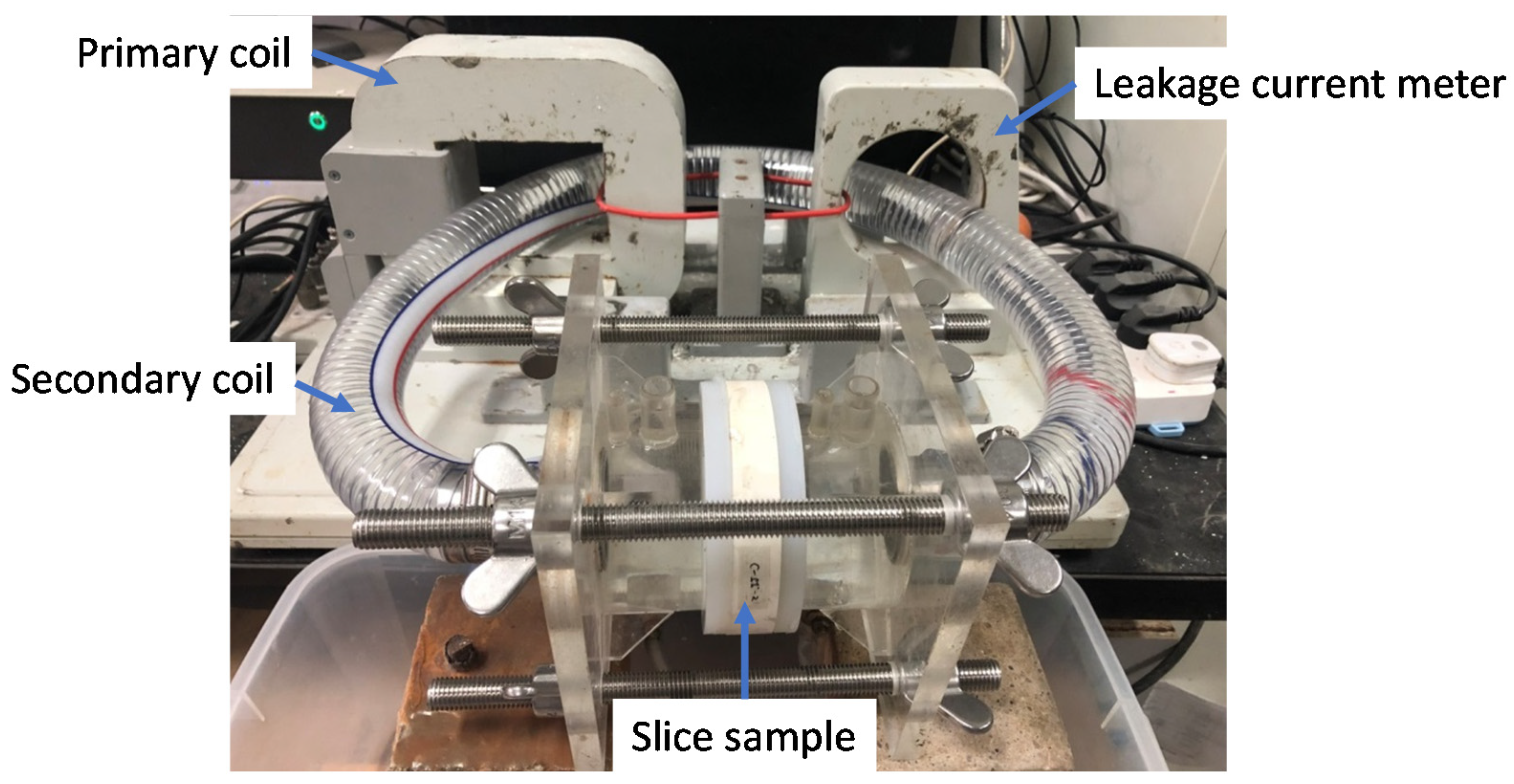
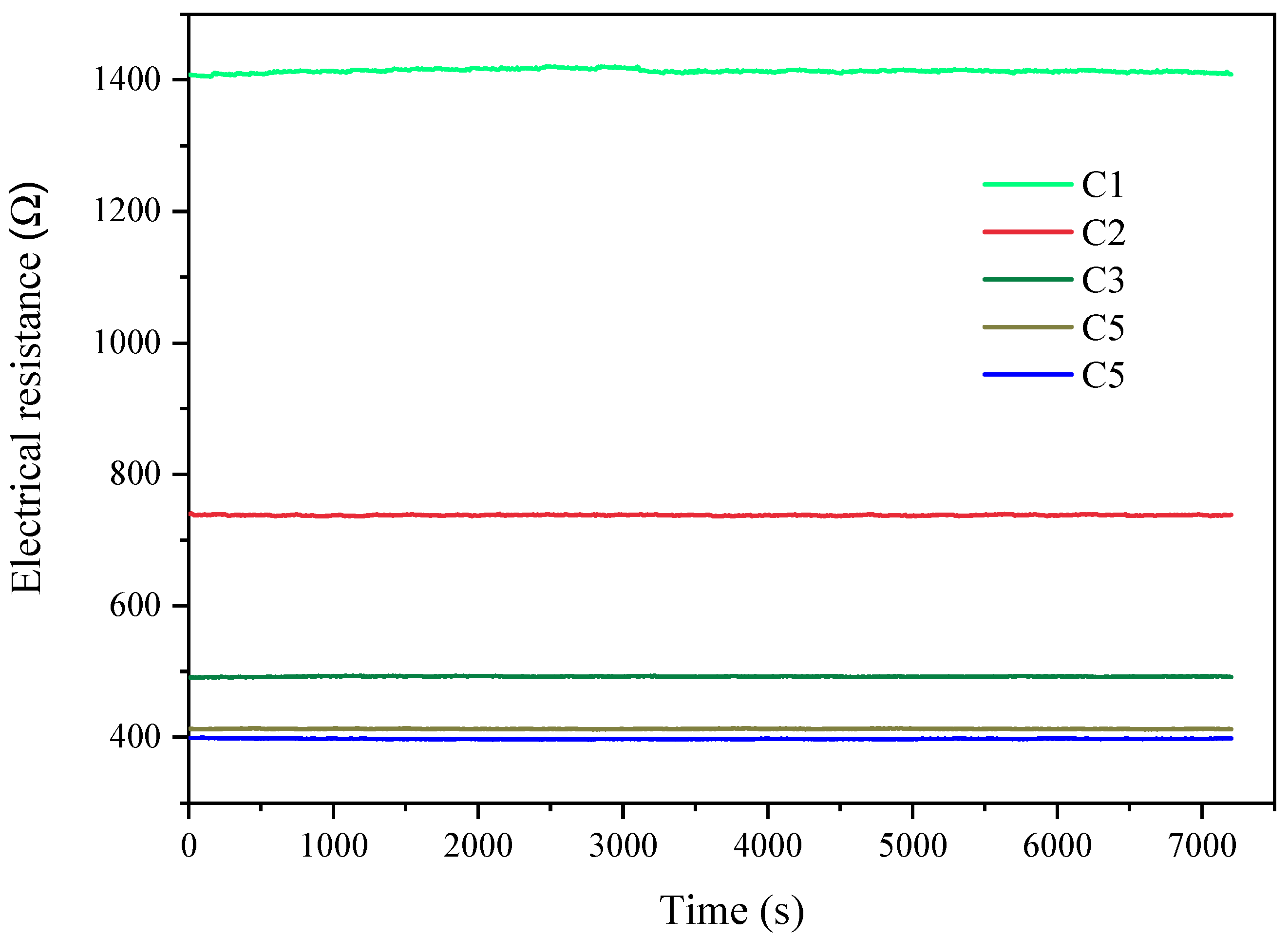
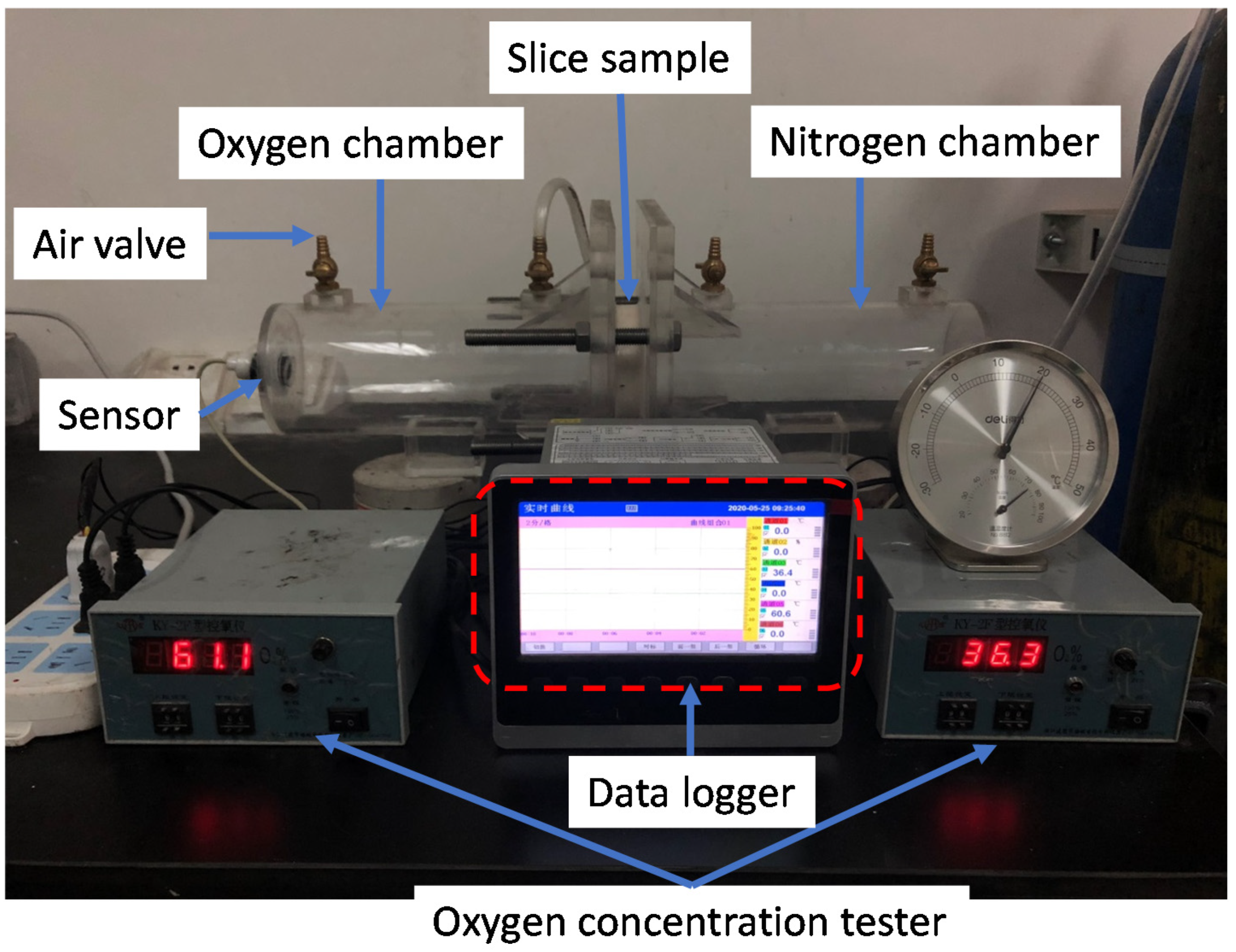

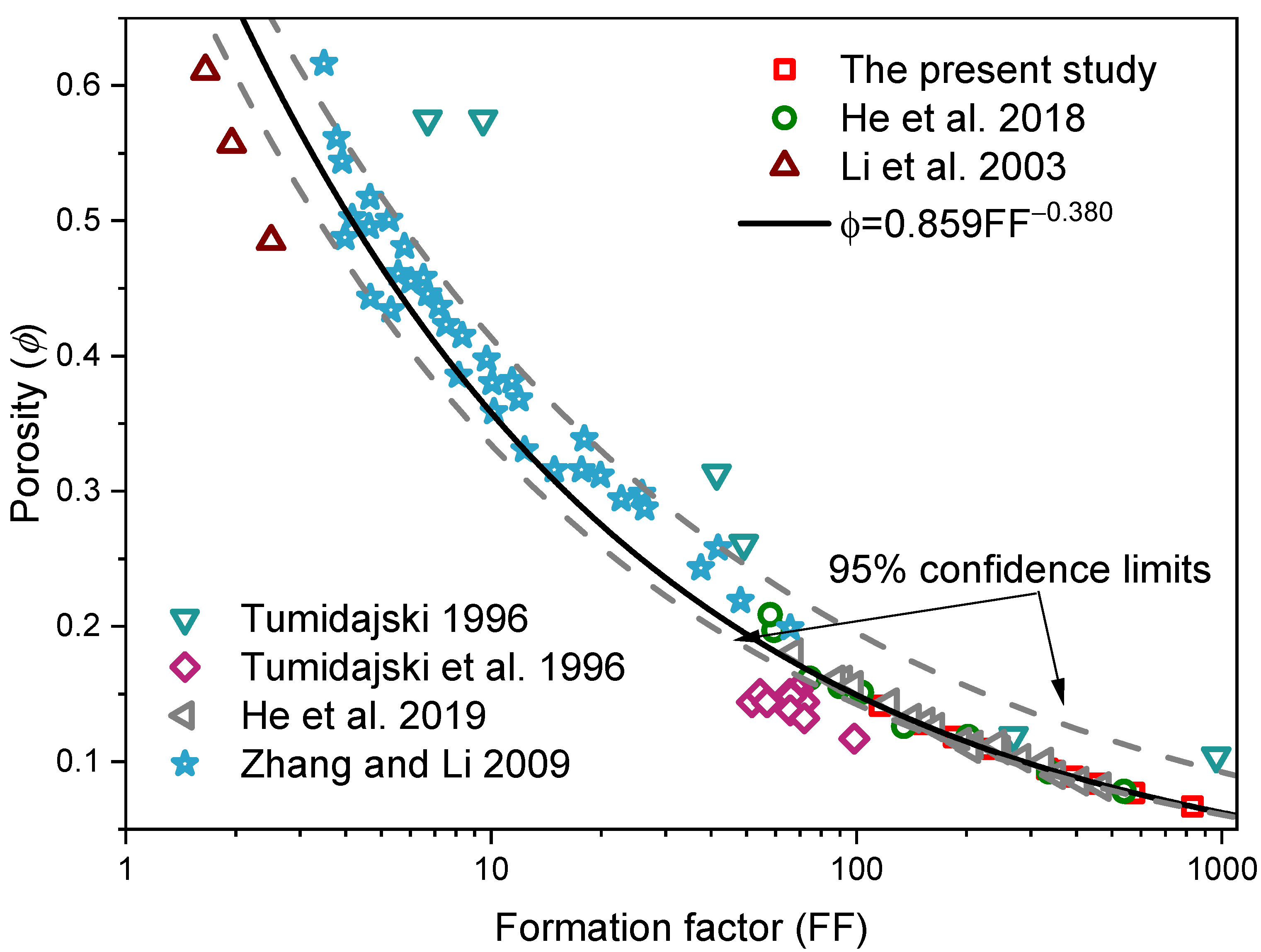

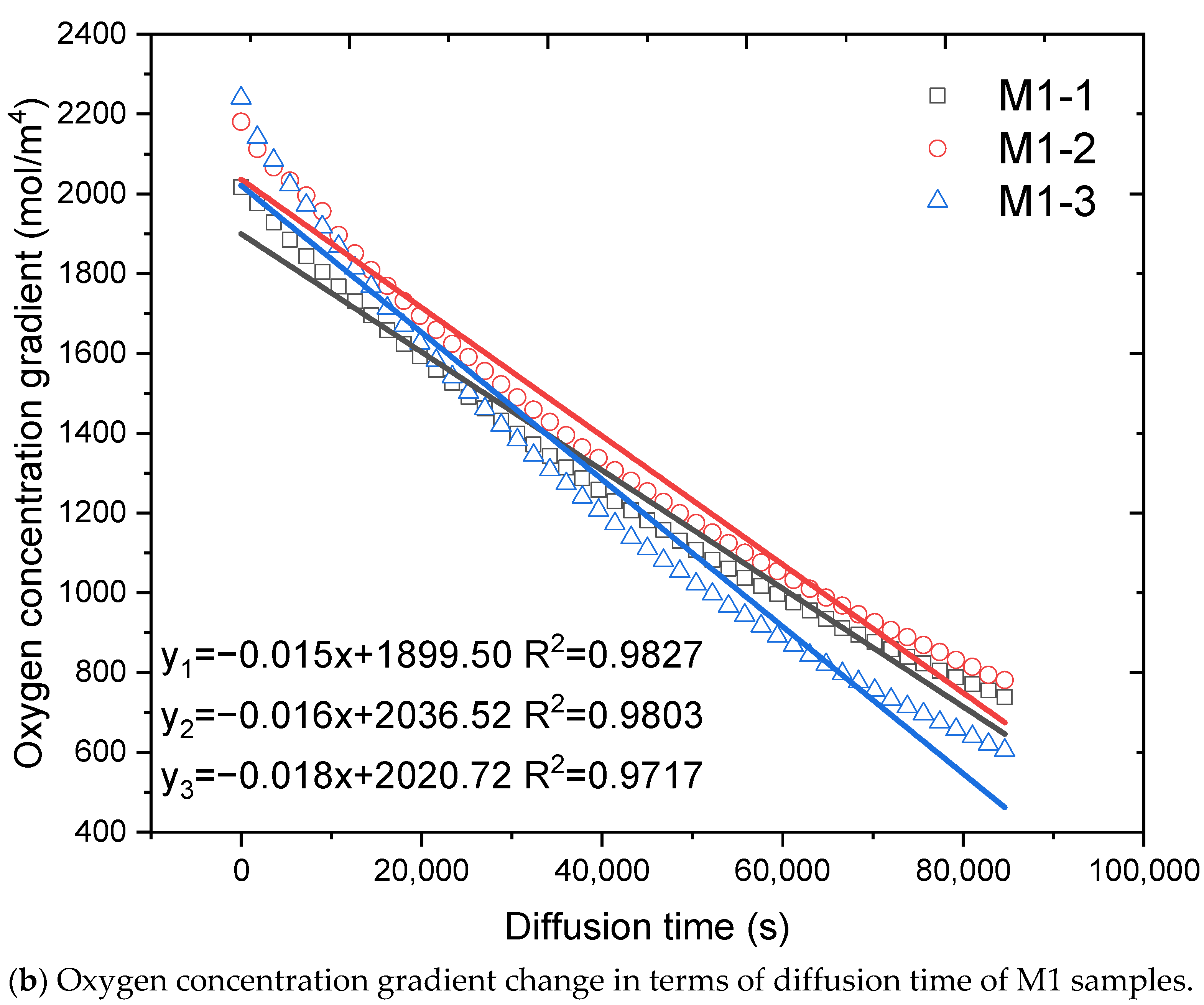
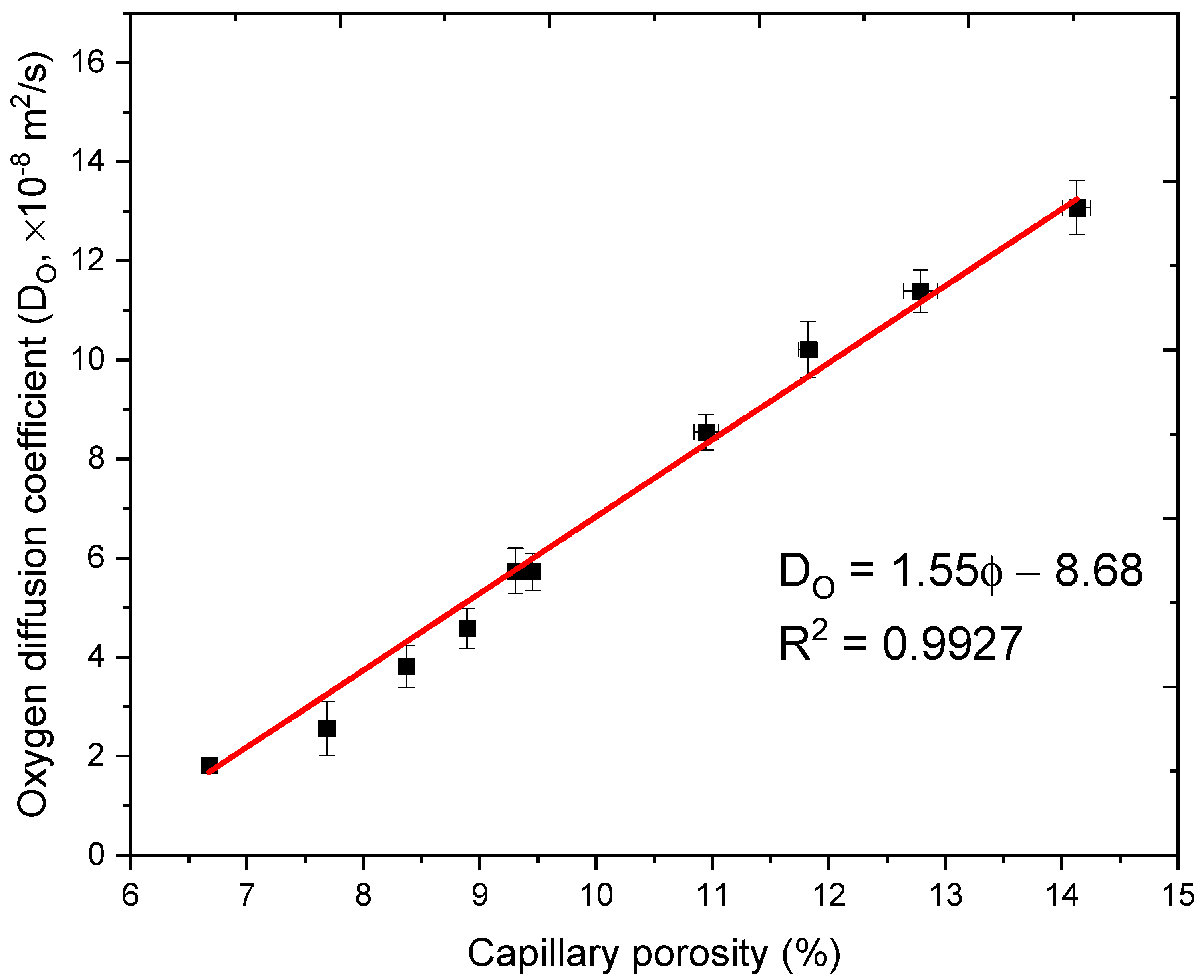

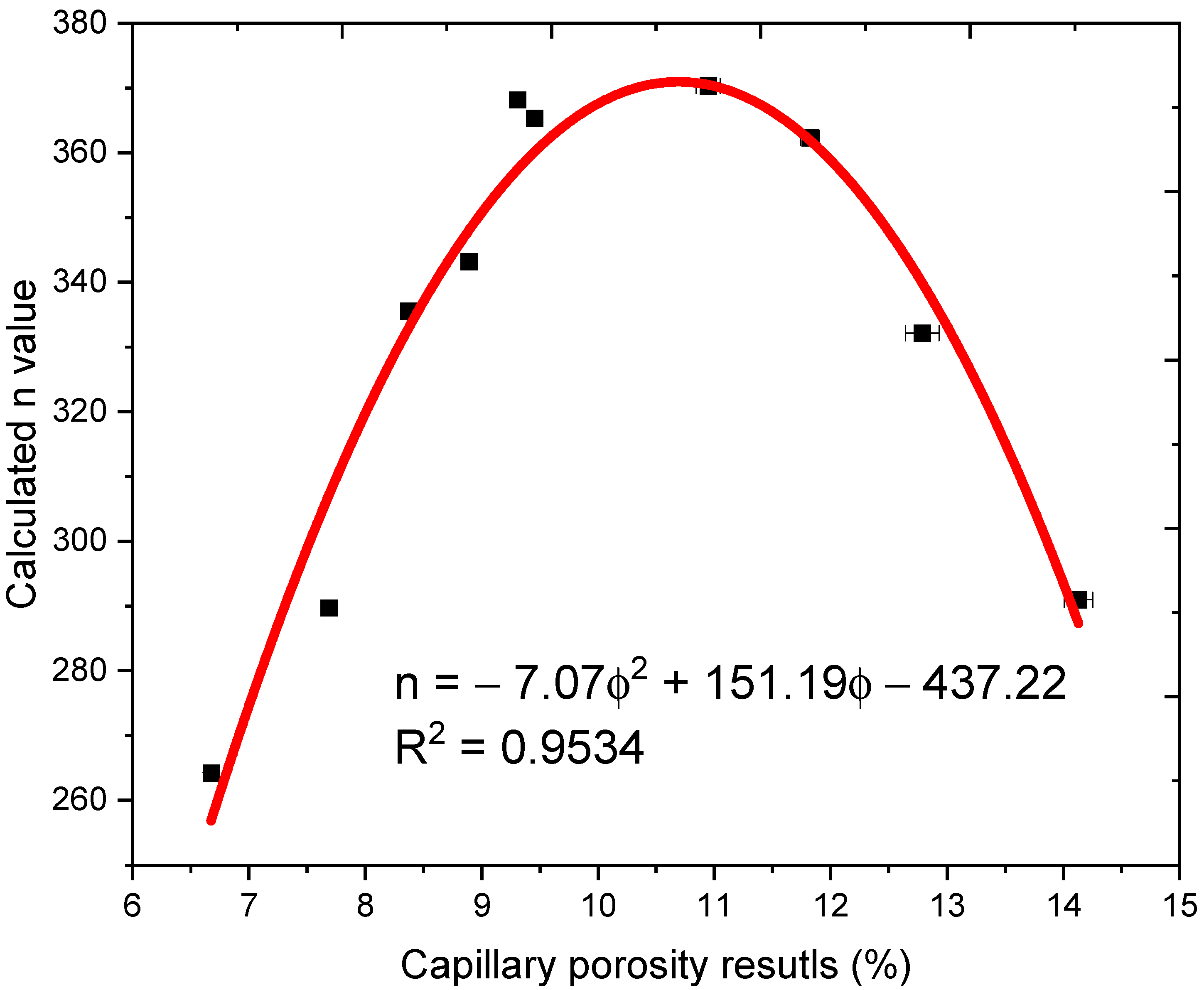
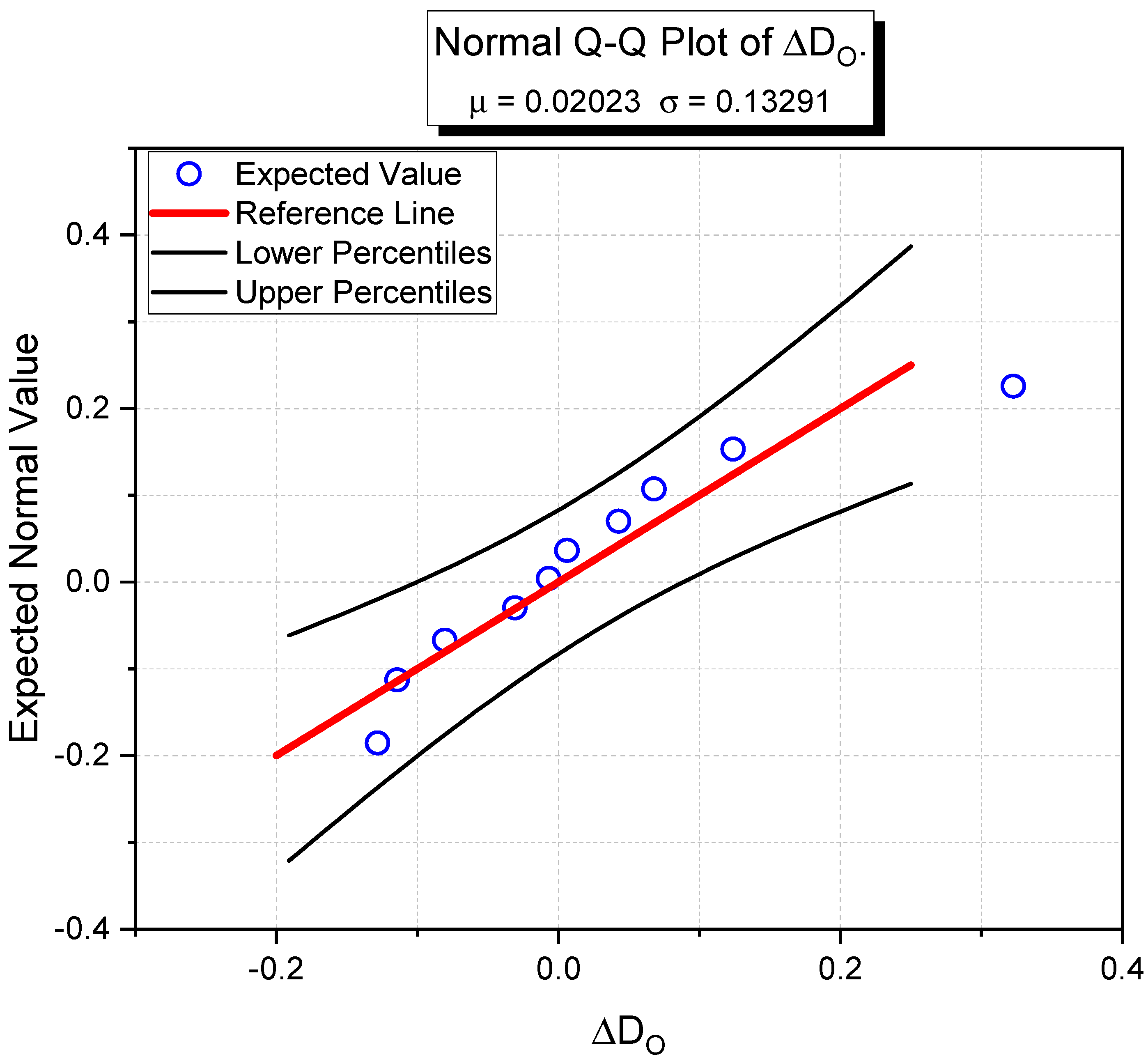
| CaO | SiO2 | Al2O3 | Fe2O3 | MgO | SO3 | LoI | Fineness (m2/kg) |
|---|---|---|---|---|---|---|---|
| 62.91 | 19.55 | 5.22 | 2.74 | 2.94 | 3.22 | 2.25 | 409 |
| Mixture ID | Design w/c | Cement | Mixing Water | Fine Agg. | Coarse Agg. |
|---|---|---|---|---|---|
| C1 | 0.39 | 335 | 130 | 860 | 1165 |
| C2 | 0.42 | 335 | 141 | 849 | 1150 |
| C3 | 0.45 | 335 | 151 | 838 | 1135 |
| C4 | 0.48 | 335 | 161 | 826 | 1119 |
| C5 | 0.51 | 335 | 171 | 815 | 1104 |
| M1 | 0.39 | 686 | 268 | 1372 | / |
| M2 | 0.42 | 672 | 282 | 1345 | / |
| M3 | 0.45 | 659 | 297 | 1318 | / |
| M4 | 0.48 | 646 | 310 | 1293 | / |
| M5 | 0.51 | 633 | 323 | 1267 | / |
| Mixture ID | Electrical Resistivity (Ωm) | Standard Dev. | Capillary Porosity (%) | Standard Dev. |
|---|---|---|---|---|
| C1 | 145.2900 | 2.5080 | 6.6733 | 0.0208 |
| C2 | 113.1833 | 2.5007 | 7.6867 | 0.0208 |
| C3 | 88.0767 | 1.3991 | 8.3700 | 0.0200 |
| C4 | 74.9367 | 2.2018 | 8.8900 | 0.0361 |
| C5 | 63.8767 | 3.0608 | 9.4533 | 0.0551 |
| M1 | 64.1451 | 1.0897 | 9.3067 | 0.0513 |
| M2 | 43.3633 | 2.0843 | 10.9467 | 0.1050 |
| M3 | 35.4867 | 1.3466 | 11.8200 | 0.0800 |
| M4 | 29.1600 | 1.0553 | 12.7867 | 0.1457 |
| M5 | 22.2633 | 0.4153 | 14.1300 | 0.1212 |
| Mixture ID | Oxygen Diffusion Coefficient (DO × 10−8 m2/s) | Standard Dev. |
|---|---|---|
| C1 (w/c = 0.39) | 1.82 | 0.1529 |
| C2 (w/c = 0.42) | 2.56 | 0.5427 |
| C3 (w/c = 0.45) | 3.81 | 0.8214 |
| C4 (w/c = 0.48) | 4.58 | 0.7027 |
| C5 (w/c = 0.51) | 5.72 | 0.5784 |
| M1 (w/c = 0.39) | 5.74 | 0.4612 |
| M2 (w/c = 0.42) | 8.54 | 0.3594 |
| M3 (w/c = 0.45) | 10.21 | 0.5594 |
| M4 (w/c = 0.48) | 11.39 | 0.3249 |
| M5 (w/c = 0.51) | 13.07 | 0.4421 |
Publisher’s Note: MDPI stays neutral with regard to jurisdictional claims in published maps and institutional affiliations. |
© 2021 by the authors. Licensee MDPI, Basel, Switzerland. This article is an open access article distributed under the terms and conditions of the Creative Commons Attribution (CC BY) license (https://creativecommons.org/licenses/by/4.0/).
Share and Cite
Zhou, R.; Li, Q.; Wang, J.; Zhou, K.; He, R.; Fu, C. Assessment of Electrical Resistivity and Oxygen Diffusion Coefficient of Cementitious Materials from Microstructure Features. Materials 2021, 14, 3141. https://doi.org/10.3390/ma14123141
Zhou R, Li Q, Wang J, Zhou K, He R, Fu C. Assessment of Electrical Resistivity and Oxygen Diffusion Coefficient of Cementitious Materials from Microstructure Features. Materials. 2021; 14(12):3141. https://doi.org/10.3390/ma14123141
Chicago/Turabian StyleZhou, Renzhan, Qiang Li, Jiandong Wang, Kewen Zhou, Rui He, and Chuanqing Fu. 2021. "Assessment of Electrical Resistivity and Oxygen Diffusion Coefficient of Cementitious Materials from Microstructure Features" Materials 14, no. 12: 3141. https://doi.org/10.3390/ma14123141
APA StyleZhou, R., Li, Q., Wang, J., Zhou, K., He, R., & Fu, C. (2021). Assessment of Electrical Resistivity and Oxygen Diffusion Coefficient of Cementitious Materials from Microstructure Features. Materials, 14(12), 3141. https://doi.org/10.3390/ma14123141






